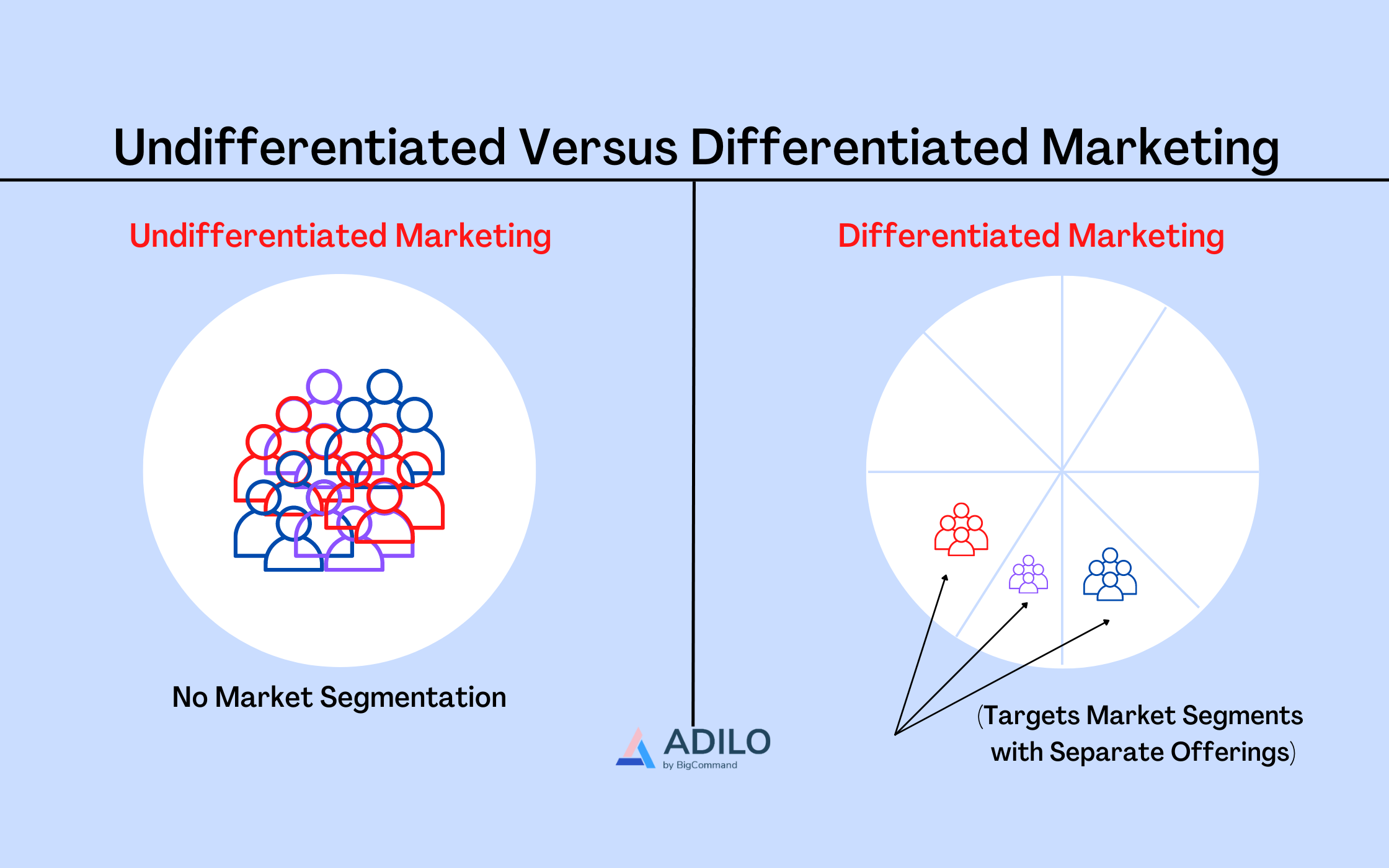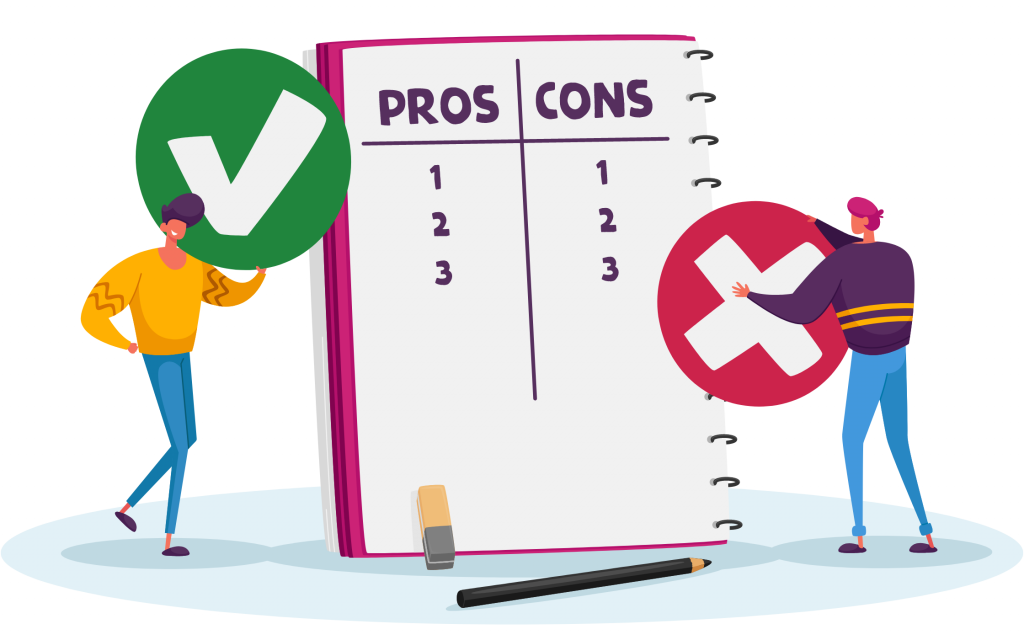What is Differentiated Marketing?

Differentiated marketing is a marketing strategy whereby a single organization creates multiple marketing campaigns to appeal to different target audiences. Differentiated marketing can also be alluded to as multi-segment marketing.
Differentiated marketing targets various market segments and provides distinct benefits to each. For example, retailers of organic dog food engage the differentiated marketing strategy to reach various audiences, such as animal lovers, eco-conscious individuals, and health-conscious consumers.
Another example of businesses that engage the differentiated marketing strategy are businesses that sell dietary supplements to multiple target audience segments, ranging from individuals looking for specific nutritional supplements to those who prefer general multivitamins.
In differentiated marketing, businesses can effectively articulate their value proposition to various market segments and, ideally, increase the success of their marketing strategy. Differentiated marketing aims to increase sales and market share across all target segments.
Concepts of Differentiated Marketing

- Total Market: The total market is the whole market comprising people who have various characteristics, interests, needs, and preferences to whom an organization markets its products and services. Not everyone in the market will subscribe to an organization’s products.
- Target Market: A target market is a subset or segment of the total market comprising people with similar characteristics to whom a company markets its products or services. While customers may emerge from the entire market, a target market consists of customers who are most likely to buy what an organization sells.
- Target Marketing: Target marketing is researching and understanding the characteristics, interests, needs, and preferences of prospective customers to focus your message and marketing budget on the specific segment of the market most likely to purchase your product or service. Differentiated marketing, amongst others, is a subset of target marketing.
- Marketing Mix: The marketing mix, also known as the four Ps of marketing, are the critical mix of elements for promoting a product or service. They are the product, price, placement, and promotion of an organization’s offerings. The four Ps, or the marketing mix, are constrained by internal and external factors in the overall business environment and interact heavily with one another.
The four Ps help businesses figure out what their customers want, how their products and services are regarded in the world, how their products or services meet or fail to meet those needs, how they interact with their customers, and how they differentiate themselves from their competitors.
- Brand Positioning: Brand positioning is designing a company’s offerings to occupy a distinct position in its competitive environment. Brand positioning entails carefully manipulating every component of the marketing mix.
- Positioning Statement: A positioning statement is an honest communication of a brand’s essence. It should explain why prospective customers should always choose a brand. It is typically three to five sentences.
Differences Between Differentiated Marketing and Undifferentiated Marketing

The undifferentiated marketing strategy focuses on the entire market rather than a segment. This strategy employs a single marketing mix, one product, one price, one placement, and one promotional effort, to reach the most significant number of consumers in that market. The success of undifferentiated marketing relies heavily on the marketer’s ability to reach a large audience.
On the other hand, a differentiated marketing strategy targets specific market segments with marketing mixes tailored to their needs. Differentiated marketing works best in markets with easily identifiable components with distinct requirements. For example, a vitamin supplement manufacturer may identify gender-based market segments and create one multivitamin formula for women and another for men.
Advantages of Differentiated Marketing
- Your organization enjoys the flexibility to test market segments: Differentiated marketing allows organizations to test the waters and dominate previously untapped market segments.
- Your organization becomes more relevant to specific demographics: Using a differentiated marketing approach, you can cater to multiple, specific groups of consumers rather than just one.
- Your organization becomes more market-relevant: By differentiated marketing, your organization can become a one-stop-shop for meeting customer needs in your niche. Your organization becomes more relevant in the marketplace.
- Your organization expands in reach and revenue: You can reach more customers by differentiating your marketing approach for selling your products and services. Assume you own a coffee shop with many college students as customers. You can aim to broaden your consumer reach to commuting professionals by diversifying your offerings. This will allow you to reach a broader audience while improving business operations. As you cater to a larger audience and their respective demands, your revenue will naturally rise as your business expands.
- Your organization enjoys increased market share: A company can gain a larger market share by increasing its sales volume and value of differentiated products. As a result, differentiation and market share have a positive relationship. Market share growth is therefore dependent on a company gaining a competitive advantage.

Disadvantages of Differentiated Marketing
- Your organization’s research and development costs will rise: The time, talent, and money required to identify the unique needs of specific target markets are greater than those required for undifferentiated marketing.
- Your organization’s marketing and management costs will rise: Differentiated marketing necessitates businesses to allocate a more significant portion of their budget to developing various marketing campaigns to reach diverse segments. It also implies that there will be added costs for effective administration and management.
- Your organization may experience inconsistencies across segments: Inconsistencies in results can occur for various reasons. Customers, for example, may value and require different offerings at different rates and times, causing the results and revenue generated across segments to differ.
- Inability to generate insights: Variable customer responses may make it difficult to create specific customer insights.
When to Use a Differentiated Marketing Strategy

When should you consider employing a differentiated marketing strategy? Here are some scenarios where it could be a viable option:
- When you have outgrown your current niche.
- When you are losing your competitive advantage in an undifferentiated market.
- When your profit margins are thinning. Research shows that differentiated services typically have higher profit margins than undifferentiated services.
- When you want to maximize the value of your organization, a differentiated strategy enables you to acquire and maximize valuable niches by tailoring your marketing strategy to the wants and needs of individual segments.
How to Create a Differentiated Marketing Strategy
Step 1: Define your target market

You must first determine your customer’s primary characteristics, such as their location, gender, age, income, and marital status. When researching, focus on your best and most desirable customers within each segment. It will also help you understand how your customers look for new providers and where they get their information.
Step 2: Understand your customers’ needs

You must determine which products and services your customers prefer. A survey or feedback form can help gather this information. You can also use data analytics to track your customers’ purchasing habits and target them accordingly.
Step 3: Position your brand

Brand positioning begins with identifying your differentiating factors, which must be accurate, provable, and relevant. After determining your differentiators, you must write a focused, simple positioning statement. Although your brand’s positioning must be consistent across all audiences, your messaging strategy should be tailored to the needs of your market segments.
Step 4: Define and refine your products and services

Identify the distinctive features of each target segment and try to promote offerings that are most appealing to each piece.
Step 5: Choose your marketing channels

Reach out to your prospects via their preferred channels once you identify how and where they search for information or service providers like you. Making your expertise more tangible and visible to your target audience is vital. Research shows that combining traditional and digital techniques best achieves high visibility.
Step 6: Equip yourself with the necessary skills and tools

Some useful tools for implementing a successful differentiated marketing strategy are as follows:
– Website: Create or improve your website to represent your brand, showcase your offerings, and provide a positive customer experience.
– Social media: Maintain top-of-mind awareness among customers in your target market by consistently delivering good content across your social media platforms.
– Marketing collateral: Create marketing materials such as company overview decks, brochures, one-page service descriptions, and trade show materials.
– Videos: Given people’s desire to be constantly entertained by videos, including a video on your product or service webpage can significantly increase visitor time, giving visitors more time to like, trust, and buy what you’re selling. Your organization can use the following types of videos:
– Product feature video
– Explainer video
– Company culture video
– Onboarding video
– Livestreams
– Event recap video
– Promotional video
– Social media video
– Sales presentation
– Testimonial video
– Emails: It is essential to appeal to their consciences in the language they understand. Send emails consistently that will engage your target market and showcase your product offerings.
– Search engine optimization tools: Search engine optimization, or SEO, is the process of improving your website’s ranking on search engines such as Google and Bing. WordPress SEO, Keyword Research, and Mobile SEO are examples of SEO tools that provide data about your website’s overall health and success. They help identify opportunities and weaknesses that may impede the ability of your website to rank and earn visibility.
– Marketing automation: Marketing automation is a technology that automatically manages marketing processes and multifunctional campaigns across multiple channels. Marketing automation allows businesses to target customers with automated messages via email, web, social media, and text. Welcome emails, birthday emails, and product updates are marketing automation examples. Marketing automation tools include Marketo, HubSpot, and Customer.io.
– Proposal templates: A well-written proposal can outline your value proposition and persuade customers and organizations to work with you. They can act as a link between you and potential clients. You should always keep one on hand.
– Talent: Recruiting and retaining qualified talent who will tirelessly market your offerings is critical. A well-meaning marketing strategy will reach its climax with the right team.
Step 7: Document your operational schedule and budget

Your written plan should include specific timelines and deadlines to track your progress against them. Did a task go off as planned? Did it produce the expected results? These findings are used as input for the next round of marketing planning.
You will need a marketing calendar and a marketing budget. The marketing calendar should include every tactic you intend to use. It may cover the next quarter or even the entire year. Begin by entering any events you know, such as annual conferences and speaking engagements. Include all regular blog posts, emails, trade shows, and webinars.
Estimate the cost for a single instance of recurring elements such as advertising, then multiply by the frequency. Use benchmarks when available, and do not forget to budget for contingencies, typically 5–10% of the total budget. Allow for last-minute changes, but stay within your marketing budget.
Step 8: Implement your strategy

After planning, put your differentiated marketing strategy into action. Implement your content marketing strategies for blog posts, videos, and podcasts to educate your customers about your products or services. Advertise on social media platforms where your target audience spends their time. Differentiate your organization!
YOU MAY ALSO LIKE: What Market Segmentation Actually Means
You love this article, right? Get more updates via Adilo’s Twitter Page.













